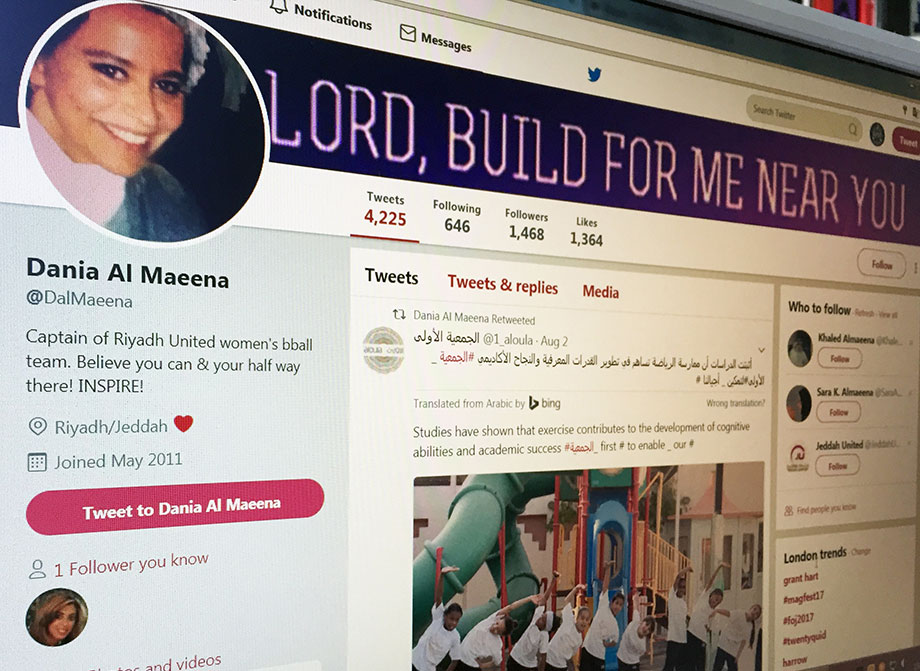One of the enduring images from the Olympic Games in 2012 was of 800m runner Sarah Attar: alone but determined at the back of the field, arguably achieving a greater feat than any of her fellow competitors. She and judo competitor Wojdan Shaherkani made history as the first female Saudi Olympians: the Saudi Olympic Committee had finally lifted their ban on women competing in the Games.
But while gradual progress is being made at an elite level, there is a big grass-roots issue to tackle in the country. The World Health Organization report in 2014 stated that more than 60% of adults in Saudi Arabia are classified as insufficiently active. The report also finds that young people are being diagnosed with diabetes and obesity in increasing numbers. Brunel University London researcher Razan Baker says the problem also has a gender bias. “Due to cultural reasons preventing women from participating in physical activity as freely and equally as their male peers, Saudi Arabia has seen an increasing percentage of obese women.”
Study unveils what inspires youth sport
As a freelance sports journalist, Razan covered sport in Saudi Arabia for several years. She chose to undertake a PhD at Brunel to examine what influences young people in the kingdom to get involved in sport and how critical this is to increasing participation.
Previous research tended to focus on western countries, and indicated that self-motivation is the key to increasing physical activity. But Razan has discovered evidence to suggest that, in Saudi Arabia, family, peers, schools and sports organisations all have a major impact – and that social media is playing a huge part in this.
“Families have the strongest effect on the participation of youth, and fathers in particular are the models behind female participation,” says Razan, whose own father, and uncles, she cites as the main reason for her passion for sport. “I wanted to follow in their footsteps by taking my interest in sports and physical activity to a higher level,” she recalls.
Razan’s study also found that friends were central to increasing participation. “Friends share almost 16 hours of the day together” she points out – “half of it at school and half through online social networks, where they continue to share their views and discuss mutual interests”. Friends were found not only to introduce one another to new activities, but they also provided mutual encouragement.
The influence of ‘physical activity activists’ was also evaluated. These activists, including Saudi sports stars, are engaging with young people – particularly on Twitter. By sharing emotional support, awareness and health and fitness information, these activists have attracted growing numbers of young followers.

But the study found that government, health and education institutions are behind the curve. Since starting to embrace platforms like Twitter, Facebook and Instagram in the past two or three years, they have begun to be influential to young people, providing information and publicising opportunities. “These organisations should stop putting the responsibilities onto other institutions” says Razan, “and should evaluate their own plan and amend it until they reach their goals. They must keep engaging young people and their parents in their planning process”.
Overcoming the limits of segregation
Gender segregation is obligatory by law and culture in Saudi Arabia, but social media has enabled people to communicate while remaining physically segregated.
Just a few years ago, Saudi women faced harsh criticism online when engaging in discussions about sport. Wojdan Shaherkani and her family filed a lawsuit against online abusers in one of the first cases since Saudi cyber-crime laws were introduced. The study shows that such online attacks have subsequently eased: “With the new government led by King Salman Al Saud in 2015, and the door he opened for women in many fields including sports, no-one was able to question royal decrees or abuse females in sports like before. People became more aware of the importance of physical activities to both sexes.”
A healthier future
Overall, the study found that online social networks increased participation among both genders. But most notably, Razan found they “broke barriers present in offline networks, especially for women, who finally managed to find a platform to communicate, share their experiences in the field and support each other.”
The researcher has recommended policy reviews within public institutions – such as the General Authority of Sports, Ministry of Education, and also media outlets – to ensure information about healthy lifestyles reaches young people and their parents.
“Providing legal, sustained and regulated information, facilities and services in the country ... will enable more young people to participate in physical activity – especially women in the government-run schools.”
“I would like to see both sexes enjoy the same opportunities which will lead to a healthy and active society,” concludes Razan. “We need more role models who excel in their education and physical activities, because I believe having both provides a balanced and successful lifestyle. The government schools are expected to introduce physical activities for female students this academic year, so that is a huge step forward. The situation is promising.”
(Image: CC by flickr/martinhesketh)
Reported by:
Vicky Phillips,
Media Relations
victoria.phillips@brunel.ac.uk